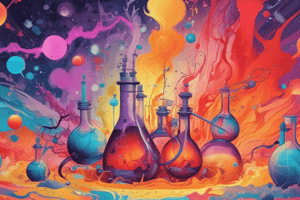Podcast
Questions and Answers
What is the purpose of adding HCl to the reaction mixture in Part A?
What is the purpose of adding HCl to the reaction mixture in Part A?
- To shift the equilibrium to the left (correct)
- To increase the concentration of CNS⁻ ions
- To form a complex ion with Fe³⁺
- To decrease the concentration of Fe³⁺ ions
What happens to the equilibrium mixture when it is exposed to hot water in Part B?
What happens to the equilibrium mixture when it is exposed to hot water in Part B?
- The solution becomes colorless
- The solution becomes more red
- The solution remains unchanged
- The solution becomes lighter in color (correct)
What is the effect of adding potassium thiocyanate (KSCN) solution to the reaction mixture in Part A?
What is the effect of adding potassium thiocyanate (KSCN) solution to the reaction mixture in Part A?
- The equilibrium shifts to the left
- The reaction becomes exothermic
- The equilibrium shifts to the right (correct)
- The reaction becomes endothermic
What is the conclusion of the experiment regarding the effect of temperature on the equilibrium reaction?
What is the conclusion of the experiment regarding the effect of temperature on the equilibrium reaction?
What is the role of iron(III) chloride (FeCl₃) in the experiment?
What is the role of iron(III) chloride (FeCl₃) in the experiment?
What is the significance of the color change observed in the experiment?
What is the significance of the color change observed in the experiment?
How does the addition of HCl affect the equilibrium reaction in Part A?
How does the addition of HCl affect the equilibrium reaction in Part A?
What is the effect of temperature on the equilibrium reaction, as observed in Part B?
What is the effect of temperature on the equilibrium reaction, as observed in Part B?
What is the purpose of using iron(III) chloride and potassium thiocyanate in the experiment?
What is the purpose of using iron(III) chloride and potassium thiocyanate in the experiment?
What is the significance of Le Chatelier's principle in the context of this experiment?
What is the significance of Le Chatelier's principle in the context of this experiment?
Flashcards are hidden until you start studying
Study Notes
- The experiment demonstrates the Chatelier's principle by studying the effects of concentration and temperature changes on the reaction Fe³⁺ + CNS⁻ ⇌ FeCNS²⁺.
- The reaction involves iron(III) chloride (FeCl₃) as the source of Fe³⁺ ions and potassium thiocyanate (KSCN) as the source of CNS⁻ ions.
- Fe³⁺ ions are yellow, and CNS⁻ ions are colorless, but when combined, they form a complex ion, FeCNS²⁺, which is red.
- In Part A, the effect of concentration on the equilibrium reaction is investigated by adding HCl and KSCN solutions to the reaction mixture.
- Adding HCl causes the red color to disappear, shifting the equilibrium to the left, as the CL⁻ ions are absorbed.
- Adding KSCN solution causes the solution to become red again, shifting the equilibrium to the right, as the CNS⁻ ions are absorbed.
- In Part B, the effect of temperature on the equilibrium reaction is investigated by diluting the solutions and exposing them to different temperatures (hot water, ice, and room temperature).
- The red color becomes lighter in the hot water test tube, indicating a shift to the left (endothermic reaction), and the yellow color appears.
- The equilibrium mixture becomes more red in the ice test tube, indicating a shift to the right (exothermic reaction), but this is difficult to detect.
- The experiment concludes that adding heat favors the direction of the endothermic reaction, and removing heat favors the direction of the exothermic reaction.
Studying That Suits You
Use AI to generate personalized quizzes and flashcards to suit your learning preferences.




